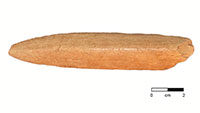People of the Woodland Tradition
(c. 1000 B.C. – A.D. 1750)
As the climate of the state continued to stabilize, the region’s inhabitants began to use the resources available to them in an increasing variety of ways. In northern Minnesota, hunting and gathering, which had been the primary way of life, was augmented by a seasonal round focused on the types of fish, game, and plant resources locally abundant at different times of the year. In central and southern Minnesota, the Woodland period was marked by the introduction of domesticated plants such as squash, gourds, and beans. More reliable food sources led to the long-term occupation, or the reoccurring seasonal visitation, of village and campsite locations. Tied to this increased environmental stability and regional settlement patterns were the introduction of pottery and the construction of earthen mounds. These changes occurred in Minnesota between approximately 3,000 and 900 years ago. The period in which these innovations occurred is referred to as the Woodland Tradition.
More is known about the Woodland Tradition than earlier cultural periods because Woodland archaeological sites are more widely distributed and typically not as deeply buried as sites dating to the Paleoindian and Archaic periods. Because more of these sites have been excavated, the relative abundance of Woodland artifacts has enabled archaeologists to further divide the era into Early, Middle, and Late Woodland periods, and to assign sites to regional traditions often on the basis of associated pottery styles. In addition to pottery, Woodland people made small triangular arrowheads and artifacts carved from animal bone such as barbed harpoons and awls. The excavation of Woodland sites in northeast Minnesota indicates that the seasonal round of the region’s inhabitants focused on the availability of fish, large mammals, and wild rice as well as other types of local resources.
Woodland period archaeological sites are poorly represented within Duluth in part because the amount of development present along the shoreline has obscured them. Certainly the river deltas along the Lake Superior shore and the bays of the St. Louis River estuary would have been ideal locations for warm season fishing villages typical of the Woodland period. In the greater Duluth region, Woodland period sites have been documented around inland lakes and along waterways.
Associated Images
click for larger image with caption
Copyright © 2022. All rights reserved.




